Will predators attack your swallows?
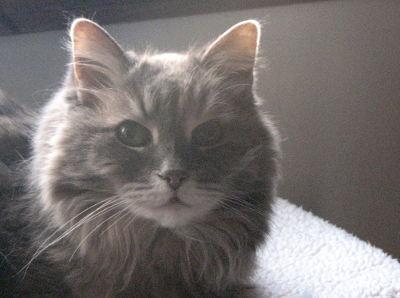
There’s always the danger that adults, young or eggs of cavity-nesting birds can be attacked and eaten by predators, so protecting your nesting Tree Swallow boxes from predators is a crucial responsibility for you as a nest box project manager. Finding boxes emptied of eggs or young, or discovering discarded wings, legs and clumps of parental feathers below a box is terribly disheartening. Please take steps to reduce chances of predation. Careful choice of project site and proper location of boxes on that site will limit risk of predators finding your boxes, but you should also try to prevent predators from reaching any boxes they do happen to discover.
What animals predate nesting Tree Swallows?
- Raccoons, cats, and opossums will kill and eat any adults and young they can pull out of boxes.
- Raccoons are especially dangerous because if they find one box and successfully predate it, they will look for other boxes and may predate every box you have.
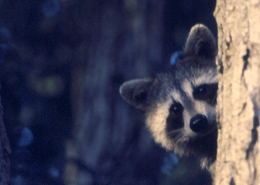
- Squirrels are also important predators of cavity-nesting bird eggs and young, and if box entrances are too small, squirrels can chew their way in.
- And chipmunks, though cute, predate more bird nests than most people realize. Photo below by Barry Scully.
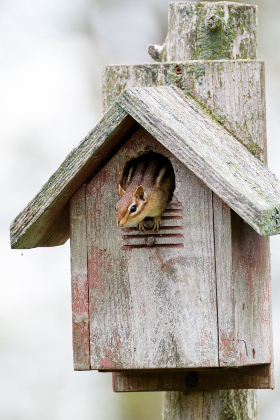
- Weasels are so slender they can enter most boxes they can reach. The photo below of a Short-tailed Weasel exiting a predated box is by Barbara Russell.
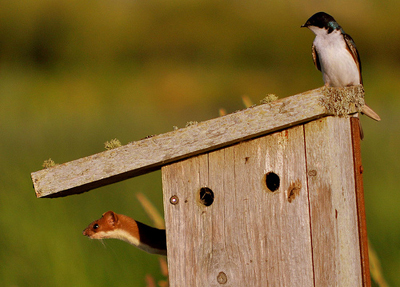
- Most snakes can’t climb poles, but a few species can, and will enter boxes to eat eggs, young or adults trapped inside.
Don’t let this happen!
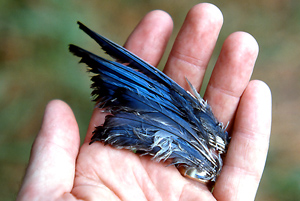
How can you stop predators from reaching boxes?
- Make it difficult and unpleasant! The best method is to attach an effective predator guard to the pole below the box.
- You should use a guard for every box because raccoons can get up even thin metal poles surprisingly easily, as the photo below taken during experiments conducted by bluebird expert Keith Kridler demonstrates.
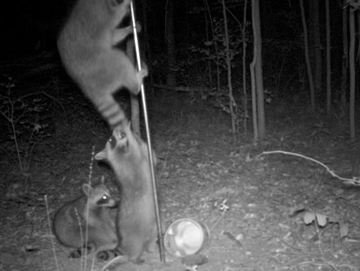
- Conical and Stovepipe Guards (see below) may be effective with some predators, but they can be expensive to make and expensive to buy.


- Hardware Screen Guards or Noel Guards (see below) that project out around the entrance hole are less expensive, but we advise against them for protecting Tree Swallow boxes from predators. The wire is difficult and time-consuming for adult swallows to cross when feeding nestlings.
- Noel Guards are also dangerous for swallow nestlings that may climb out on them and fall. (And note the overlarge hole and small dimensions of the box below; obviously not a good design for Tree Swallows).
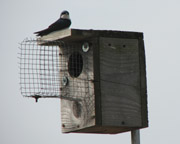
- We think modified Purple Martin Tunnels, like the ones below, are safer alternatives to Noel Guards for protecting boxes from predators.
- Click here to learn how we adapt martin tunnels for Tree Swallow boxes and gourds.
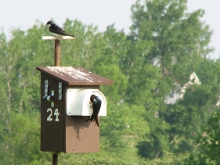
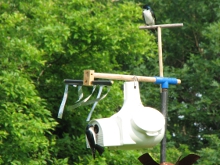
- For more information on protecting boxes from predators and making predator guards check the Sialis bluebirding web site’s predator guard page.
Our System – Can and Grease Predator Guards:
- We use simple, cheap guards made using large juice or restaurant supply cans.

- Can ends are removed and the sides cut in strips that are bent out.
- Note: One cut goes all the way through so the can will fit around a pole.
- Warning: Freshly-cut can edges may be sharp!
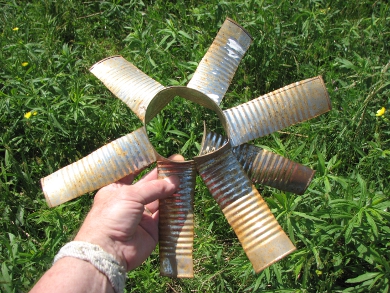
- The cans are supported by three pieces of house construction “hanger strap” fastened to poles by hose clamps.
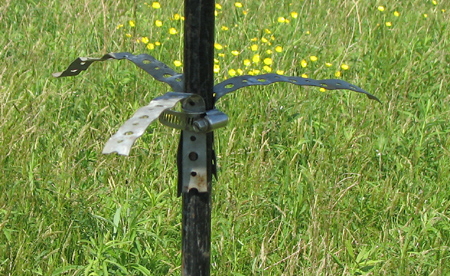
- Rounding the portions of the hangers that touch the poles makes them fit better and allows them to be tightened more securely.
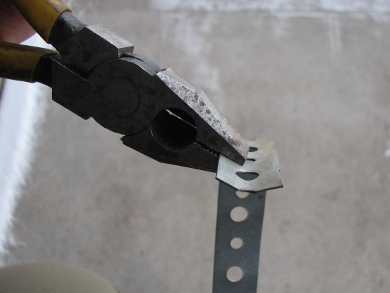
- Three or more can guards are then stacked loosely on top of the hangers.
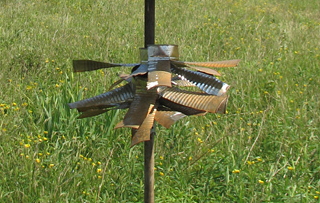
- Adding a band of engine grease about 4 inches wide directly below the predator guard makes the barrier even more effective at protecting boxes from predators.
- This grease (see below) also discourages ants from reaching nests.
- Some ant species will build nests within bird nesting material inside boxes. This they may disturb or injure young birds and can cause adult birds to desert.
- Note: You may need to reapply grease during a season.
Caution: Don’t over-do the grease! Use only a short band, if you use any at all. You don’t want any getting on birds’ feathers. The pole below has too much grease!
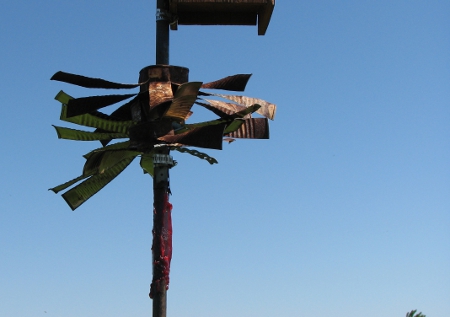
Caution: Don’t add can guards and grease until females begin incubating.
- Most predation by mammals occurs at night. However, male Tree Swallows almost never roost overnight in boxes, and females usually don’t until they’ve begun to incubate eggs.
- If you add guards before or during egg-laying, swallows competing for boxes could be injured by the cans’ edges.
- If you add grease before or during egg-laying, competing swallows could get their feathers fouled.
Here are two other sources of information regarding protecting boxes from predators which you may want to investigate:
- How to protect nest boxes from predators, from the Wildlife Society.
- Protecting Birdhouses from Predators, from The Spruce.
——————————————————————————
Home: Tree Swallow Nest Box Projects
Creating Tree Swallow Nest Box Projects
Spring Return
Nesting Season Behavior
Song and Calls
Nest Site Claiming
Pair Formation
Nest Building
Bird Flight
Mating and Paternity
Diary of One Season at Salmon Creek
Monitoring Nest Boxes and Keeping Records
Making Box Checks Keeping Box Records Control Sheets Season Summaries Print Sheets
Banding Your Tree Swallows Banding Adults Banding Nestlings
Tree Swallows in Research Research Bibliography Glossary of Terms